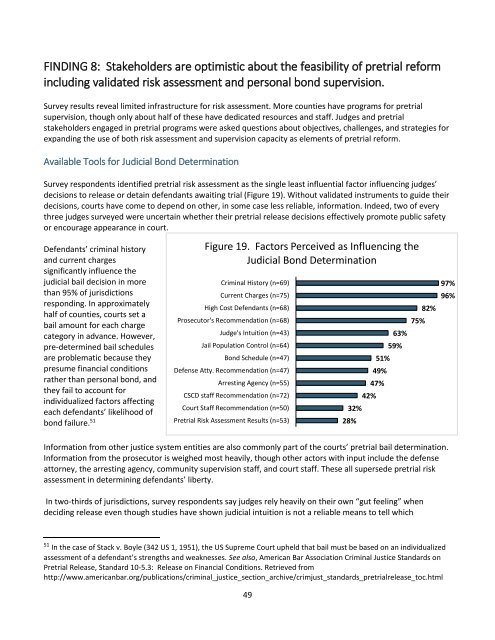LIBERTY AND JUSTICE PRETRIAL PRACTICES IN TEXAS
170308_bond-study-report
170308_bond-study-report
You also want an ePaper? Increase the reach of your titles
YUMPU automatically turns print PDFs into web optimized ePapers that Google loves.
F<strong>IN</strong>D<strong>IN</strong>G 8: Stakeholders are optimistic about the feasibility of pretrial reform<br />
including validated risk assessment and personal bond supervision.<br />
Survey results reveal limited infrastructure for risk assessment. More counties have programs for pretrial<br />
supervision, though only about half of these have dedicated resources and staff. Judges and pretrial<br />
stakeholders engaged in pretrial programs were asked questions about objectives, challenges, and strategies for<br />
expanding the use of both risk assessment and supervision capacity as elements of pretrial reform.<br />
Available Tools for Judicial Bond Determination<br />
Survey respondents identified pretrial risk assessment as the single least influential factor influencing judges’<br />
decisions to release or detain defendants awaiting trial (Figure 19). Without validated instruments to guide their<br />
decisions, courts have come to depend on other, in some case less reliable, information. Indeed, two of every<br />
three judges surveyed were uncertain whether their pretrial release decisions effectively promote public safety<br />
or encourage appearance in court.<br />
Defendants’ criminal history<br />
and current charges<br />
significantly influence the<br />
judicial bail decision in more<br />
than 95% of jurisdictions<br />
responding. In approximately<br />
half of counties, courts set a<br />
bail amount for each charge<br />
category in advance. However,<br />
pre-determined bail schedules<br />
are problematic because they<br />
presume financial conditions<br />
rather than personal bond, and<br />
they fail to account for<br />
individualized factors affecting<br />
each defendants’ likelihood of<br />
bond failure. 51<br />
Figure 19. Factors Perceived as Influencing the<br />
Judicial Bond Determination<br />
Criminal History (n=69)<br />
Current Charges (n=75)<br />
High Cost Defendants (n=68)<br />
Prosecutor's Recommendation (n=68)<br />
Judge's Intuition (n=43)<br />
Jail Population Control (n=64)<br />
Bond Schedule (n=47)<br />
Defense Atty. Recommendation (n=47)<br />
Arresting Agency (n=55)<br />
CSCD staff Recommendation (n=72)<br />
Court Staff Recommendation (n=50)<br />
Pretrial Risk Assessment Results (n=53)<br />
32%<br />
28%<br />
42%<br />
51%<br />
49%<br />
47%<br />
63%<br />
59%<br />
75%<br />
82%<br />
97%<br />
96%<br />
Information from other justice system entities are also commonly part of the courts’ pretrial bail determination.<br />
Information from the prosecutor is weighed most heavily, though other actors with input include the defense<br />
attorney, the arresting agency, community supervision staff, and court staff. These all supersede pretrial risk<br />
assessment in determining defendants’ liberty.<br />
In two-thirds of jurisdictions, survey respondents say judges rely heavily on their own “gut feeling” when<br />
deciding release even though studies have shown judicial intuition is not a reliable means to tell which<br />
51<br />
In the case of Stack v. Boyle (342 US 1, 1951), the US Supreme Court upheld that bail must be based on an individualized<br />
assessment of a defendant’s strengths and weaknesses. See also, American Bar Association Criminal Justice Standards on<br />
Pretrial Release, Standard 10-5.3: Release on Financial Conditions. Retrieved from<br />
http://www.americanbar.org/publications/criminal_justice_section_archive/crimjust_standards_pretrialrelease_toc.html<br />
49


